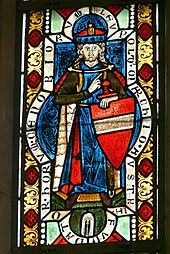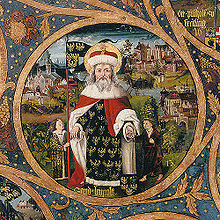Leopold III. (Austria)



Leopold III. , called the saint, the mildness or the pious (* 1073 in Gars am Kamp or Melk ; † November 15, 1136 near Klosterneuburg ) from the house of the Babenbergs , was from 1095 to 1136 margrave of the Bavarian Marcha orientalis ( Ostarrîchi ). A saint of the Roman Catholic Church since 1485 , he became the patron saint of Austria in general as well as of Vienna , Lower Austria and, together with St. Florian , of Upper Austria in particular.
Life
Leopold was the son of Margrave Leopold II and his wife Ida ; Leopold called himself Princeps Terrae , which already indicates the awareness of an independent state rule. He was also under discussion as a candidate for the election of a king in 1125 , but is said to have waived with references to his advanced age (50 years) and the number of his sons - this could have led to problems with the succession. Possible reasons are also the lack of domestic power and perhaps also the consideration for the opposing candidate Friedrich von Schwaben , his stepson. Leopold died on November 15, 1136 as a result of a hunting accident. He is buried in Klosterneuburg Abbey , which owes its existence to him.
Marriages
Leopold's family policy contributed significantly to the expansion of the property and to the social upgrading of his house.
His first marriage before 1103/1104 was Adelheid von Perg / Machland, a member of the noble family of the Lords of Perg and Machland in Machland , Upper Austria, which significantly increased his influence in what is now Lower and Upper Austria north of the Danube through acquisition of ownership and bailiwick rights could amplify. Adelheid was the daughter of Walchun I of Perg / Machland, (* c. 1050, † 1114) and Adelheid († 1090; widow of Count Heinrich II. Von Formbach and possibly Countess von Sulzbach ).
Leopold married Agnes von Waiblingen (* 1074, † 24 September 1143), a daughter of the Roman Emperor Heinrich IV (1084-1105) and his wife Bertha von Turin ( House of Savoy ) , in 1106 . Agnes was the widow of Friedrich I von Hohenstaufen , Duke of Swabia († April 6, 1105). Through this relationship with the Salians , Leopold was able to rise to the first rank of the imperial aristocracy, as he was now not only brother-in-law of Emperor Heinrich V , but also the stepfather of the Duke of Swabia, Friedrich II, and the Duke of Eastern Franconia and later German King Konrad III. von Hohenstaufen was. He was also given important royal rights in his margravate. He owes this social advancement to a - controversial - tactical maneuver in that he switched to the latter before the decisive battle between Emperor Heinrich IV and his son, who later became King Heinrich V. The Battle of the Rain River took place in connection with the investiture dispute ; Leopold and Heinrich V represented the party loyal to the Pope.
progeny
From 1st marriage:
- Adalbert "the devout" of Austria, (* c. 1098, † 1138)
He was Vogt of Klosterneuburg Monastery and all the monasteries that were under his father's bailiwick. Although he was the logical successor as the eldest son and through his training as his father's deputy, he was after the death of Margrave Leopold III. "The saint" passed over in the succession in favor of a son of the imperial daughter Agnes von Waiblingen. However, he inherited numerous properties near Mödling and Klosterneuburg as well as in the Vienna Woods from his mother . Adalbert was buried in Klosterneuburg. A stained glass window with the inscription: "Here is buried the firstborn son of St. Leopold named Adalbert, Duke of Austria, first Vogt of the monastery" reminds of him.
From the 2nd marriage there were 17 children, including:
- Heinrich II. Jasomirgott , Count Palatine of the Rhine (1140–1141), Margrave of Austria (1141–1156), Duke of Bavaria (1143–1156), 1st Duke of Austria (1156–1177), (* c. 1107, † January 13, 1177)
- ⚭ 1.) 1142 the imperial princess Gertrud , only daughter of Emperor Lothar III. (from Supplinburg)
- ⚭ 2.) 1149 Theodora Komnena , Princess of Byzantium, († 1184), a niece of Emperor Manuel I of Byzantium
- Leopold IV. Margrave of Austria (1136–1141), Duke of Bavaria (1139–1141), (* 1108, † October 18, 1141)
- ⚭ 1139 Mary of Bohemia , († c. 1160) T. v. Soběslav I. Duke of Bohemia and the Adleyta Princess of Hungary ad H. the Árpáden
- Otto of Austria, known as Otto von Freising , Bishop of Freising (1138–1158); 1138 Abbot of the Primary Abbey of the Cistercians in Morimond (in Champagne ), the famous historian, (* December 15, c. 1109, † September 22, 1158)
- Jutta of Austria
- ⚭ Liutold Count of Plain , († 1164)
- Agnes of Austria , (* 1111, † January 25, 1157)
- ⚭ 1125 Wladislaw II. Prince of Poland , Duke of Silesia (1138–1146), († 1159)
- Judith of Austria, (* c. 1115, † after 1178)
- ⚭ 1133 William V the Elder Margrave of Montferrat (Monferrato), † 1191 from the house of the Aleramides
- Konrad of Austria, Bishop of Passau (1148–1164), Archbishop Konrad of Salzburg (1164–1168), (* 1120, † September 28, 1168)
- Gertrude of Austria, (* c. 1120, † April 8, 1150)
- ⚭ 1140 Vladislav II. 1140 Duke of Bohemia , King of Bohemia (1158–1172) † 1174 (from the Přemyslid family )
- Elisabeth of Austria, (* c. 1123, † May 20, 1143)
- ⚭ 1142 Count Hermann II of Winzenburg , 1123 Margrave of Meissen , Landgrave of Thuringia († January 29, 1152)
- Bertha of Austria, (* c. 1124, † 1160)
- ⚭ Henry III. Burgrave of Regensburg , Vogt of St. Emmeram andprüfunging, Count in the Danube Bend and at the lower Altmühl († 1174)
Work and memory

He is mainly remembered for the development of the country, which goes hand in hand with his activity as a monastery founder. Its most important foundation is Klosterneuburg , which was founded in 1108. According to legend, it was the place where an apparition of Mary showed him the veil of his wife Agnes, which had been lost on the hunt during the years before. Klosterneuburg was expanded into a residence in the following years. Other monasteries were founded in Heiligenkreuz Abbey and Klein-Mariazell . These foundations served evangelization , education and the development of the still heavily forested area.
The cities were also promoted under him, in addition to Klosterneuburg and Vienna about Krems , which was given a mint. The Kremser pfennig minted in Krems gained importance on the money market.
The first German-language literary testimonies from Austria, namely by Heinrich von Melk and Ava , also come from his time .
Leopoldi Day
On January 6th, 1485 Leopold was canonized by Pope Innocent VIII , which was very much in the interests of the Habsburgs . Even before Innocent VIII, Innocent VI. and Sixtus IV also initiated canonizations of Leopold, which were discontinued. Leopold's day of remembrance is November 15th. On the occasion of the canonization and the subsequent translation ceremony , there were secular festivities such as tournaments, banquets and dances in Klosterneuburg Abbey. These merrymakers are still celebrated today, on the Leopoldi Festival, every November 15th. The celebration is popularly known as the Leopoldimarkt or Leopoldifest. Part of the attractions is the barrel slide . This is done by sliding down over the thousand-pound barrel in the binding post of the pen. The associated fair is visited by numerous people from Vienna and large parts of Lower Austria. There is no school on this day in Vienna and Lower Austria.
In 1663, under the government of his namesake Emperor Leopold I, St. Leopold in place of St. Koloman was raised to the status of patron saint of Austria. In Austria, Leopold churches were consecrated in his name.
Feast day of the king
In Belgium , November 15 has been the king's feast day (with interruptions) since 1866 , but is not an official national holiday. He was chosen by King Leopold II because it was his name day. On the other hand, the German-speaking Community in Belgium referred to the feast day of the king , which has been celebrating the day as its regional holiday since 1990 .
Awards named after Leopold
Since the 500th anniversary of his canonization in 1985, Klosterneuburg Abbey has awarded the Leopold Cross as an award to people who have made great contributions to the Abbey.
Since 2008, Klosterneuburg Abbey has awarded the St. Leopold Peace Prize to artists who deal with a humanitarian issue .
literature
- Floridus Röhrig : Leopold III. the saint, Margrave of Austria . Herold-Verlag, Vienna 1985, ISBN 3-7008-2900-0 .
- Karl Brunner : Leopold, the saint. A portrait from the spring of the Middle Ages . Böhlau-Verlag, Vienna-Cologne-Weimar 2009, ISBN 978-3-205-78351-0 . ( Review )
- Peter Molecz: The Babenbergs reflected in the liturgical remembrance of the dead. Attempt to analyze the Babenberg entries in memorial sources taking into account all family members . 2 vol., Phil. Diss. Vienna 2000.
- Hans-Josef Olszewsky: Leopold III .. In: Biographisch-Bibliographisches Kirchenlexikon (BBKL). Volume 4, Bautz, Herzberg 1992, ISBN 3-88309-038-7 , Sp. 1507-1510.
- Heide Dienst: Leopold III .. In: New German Biography (NDB). Volume 14, Duncker & Humblot, Berlin 1985, ISBN 3-428-00195-8 , pp. 277-280 ( digitized version ).
- Heinrich von Zeißberg : Leopold III. In: Allgemeine Deutsche Biographie (ADB). Volume 18, Duncker & Humblot, Leipzig 1883, pp. 382-384.
- Detlev Schwennike (Editor) European Family Tables, New Volume I, Verlag JA Stargardt, Marburg 1980.
Web links
- Entry on Leopold III. (Austria) in the Austria Forum (in the AEIOU Austria Lexicon )
- Entry on Leopold III., The saint in the database of the state's memory of the history of the state of Lower Austria ( Museum Niederösterreich )
- Entry on Leopoldi in the Austria Forum (in the AEIOU Austria Lexicon )
- Ecumenical Lexicon of Saints: Leopold III, "the Pious"
Individual evidence
- ^ Karl Brunner: Leopold, the saint. A portrait from the spring of the Middle Ages. Vienna-Cologne-Weimar 2009, p. 166.
- ↑ Database Memory of the State ( Museum Niederösterreich ): canonization of Leopold III. Retrieved December 30, 2017 .
- ↑ Floridus Röhrig: Leopold III. the saint, Margrave of Austria . Vienna 1985, p. 155.
| personal data | |
|---|---|
| SURNAME | Leopold III. |
| ALTERNATIVE NAMES | the saint (nickname); the mildness (nickname); the pious (nickname) |
| BRIEF DESCRIPTION | Margrave of Ostarrichi (1095–1136) |
| DATE OF BIRTH | 1073 |
| PLACE OF BIRTH | unsure: Melk |
| DATE OF DEATH | November 15, 1136 |
| Place of death | near Klosterneuburg |


